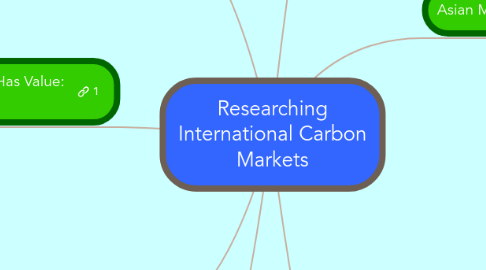
1. European Markets
1.1. The European Union Emissions Trading System (EU ETS)
1.1.1. by far the biggest international carbon market
1.1.2. http://ec.europa.eu/clima/policies/ets/index_en.htm
1.1.3. allows participants to use ERU and CER Credits
1.1.4. two types of industries:
1.1.4.1. (1) fixed installations (such as power stations, oil refineries, iron and steel plants, and other factories)
1.1.4.2. (2) the aviation industry.
1.2. Old European Trading Systems
1.2.1. Norway Domestic
1.2.2. Danish CO2 Emissions Trading System
1.2.3. United Kingdom Emissions Trading Scheme (UK ETS)
2. Why Carbon Has Value: Climate Change
2.1. Anthropogenic Greenhouse Effect
2.2. Global Warming
2.3. Carbon Dioxide Pollution
3. International: UNFCCC & Kyoto
3.1. United Nations Framework Convention on Climate Change (UNFCCC)
3.2. Koyoto Protocol
3.2.1. 4 Types of Credits
3.2.1.1. Assigned Amount Units (AAUs)
3.2.1.2. Emission Reduction Unit (ERU)
3.2.1.2.1. Comes from the Clean Development Mechanism (CDM)
3.2.1.3. Certified Emission Reductions (CER)
3.2.1.3.1. Comes from Joint Implementation (JI) projects
3.2.1.4. Removal Units (RMU)
3.2.2. Each country sets cap
3.3. Any Buyers? The failure of Kyoto
4. Types of Emissions Trading Schemes
4.1. Cap & Trade
4.2. Baseline & Credit
4.3. Voluntary Programs
5. Oceania Markets
5.1. New South Wales Greenhouse Gas Reduction Scheme (NSW GGAS)
5.1.1. 2003 - 2012
5.1.2. Baseline-and-credit
5.2. New Zealand Emissions Trading Scheme (NZ ETS)
5.2.1. Since 2008
5.2.2. Covers multiple industries
5.2.2.1. Forestry
5.2.2.2. Stationary Energy
5.2.2.3. Industrial Processes
5.2.2.4. Liquid fossil fuel (petrol)
5.2.2.5. Waste
5.2.2.6. Synthetic Gasses
5.3. Australian Federal Cap-and-Trade - 2015
5.3.1. New law passed in 2012, market expected in 2015
6. Asian Markets
6.1. Tokyo Metropolitan Government
6.2. China
6.2.1. Multiple city and province pilot programs, but really nothing functioning yet.
6.3. Japan
6.3.1. Voluntary Emissions Trading System at national level
6.3.2. Regional initatives
6.3.2.1. Tokyo Metropolitan Emissions Trading Scheme
6.3.2.1.1. Running almost 2 years, but data skewed by 21 day power outage
6.3.2.2. Provincial Emissions Trading Scheme in Saitama Prefecture
6.3.2.3. The two markets will be linked
6.4. Kazakhstan?
6.4.1. News that they will possibly persue a ETS
6.4.2. With Norwegian Help
6.5. South Korea
6.5.1. in 2012 passed legislation to start a ETS
6.5.2. Plans to launch by 2015
6.6. Taiwan
6.6.1. Baseline-and-credit type program currently, with plans for future caps.
7. North American Markets
7.1. Regional Greenhouse Gas Initiative (RGGI)
7.1.1. first mandatory cap-and-trade system in North America for CO2
7.1.2. 9 participating states
7.1.2.1. Connecticut
7.1.2.2. Delaware
7.1.2.3. Maine
7.1.2.4. Maryland
7.1.2.5. Massachusetts
7.1.2.6. New Hampshire
7.1.2.7. New York
7.1.2.8. Rhode Island
7.1.2.9. Vermont
7.1.3. first permit auction occurred in September 2008.
7.2. Western Climate Initiative (WCI)
7.2.1. US + Canada, 3 Jurisdictions currently
7.2.1.1. British Columbia
7.2.1.2. Québec
7.2.1.3. California
7.3. Midwestern Regional Greenhouse Gas Reduction Accord.
7.3.1. In 2007, the Governors of Illinois, Iowa, Kansas, Michigan, Minnesota, Wisconsin, as well as the Premier of Manitoba signed.
7.3.2. Never got past model law stage.

